This Gluten Free Sourdough Starter is perfect for baking bread, pizza, waffles, pancakes, and more! With simple ingredients and easy steps, you’ll have a sourdough starter ready for a variety of recipes. And, unlike other recipes, this one isn’t overly sour or tangy, it’s the perfect flavor.
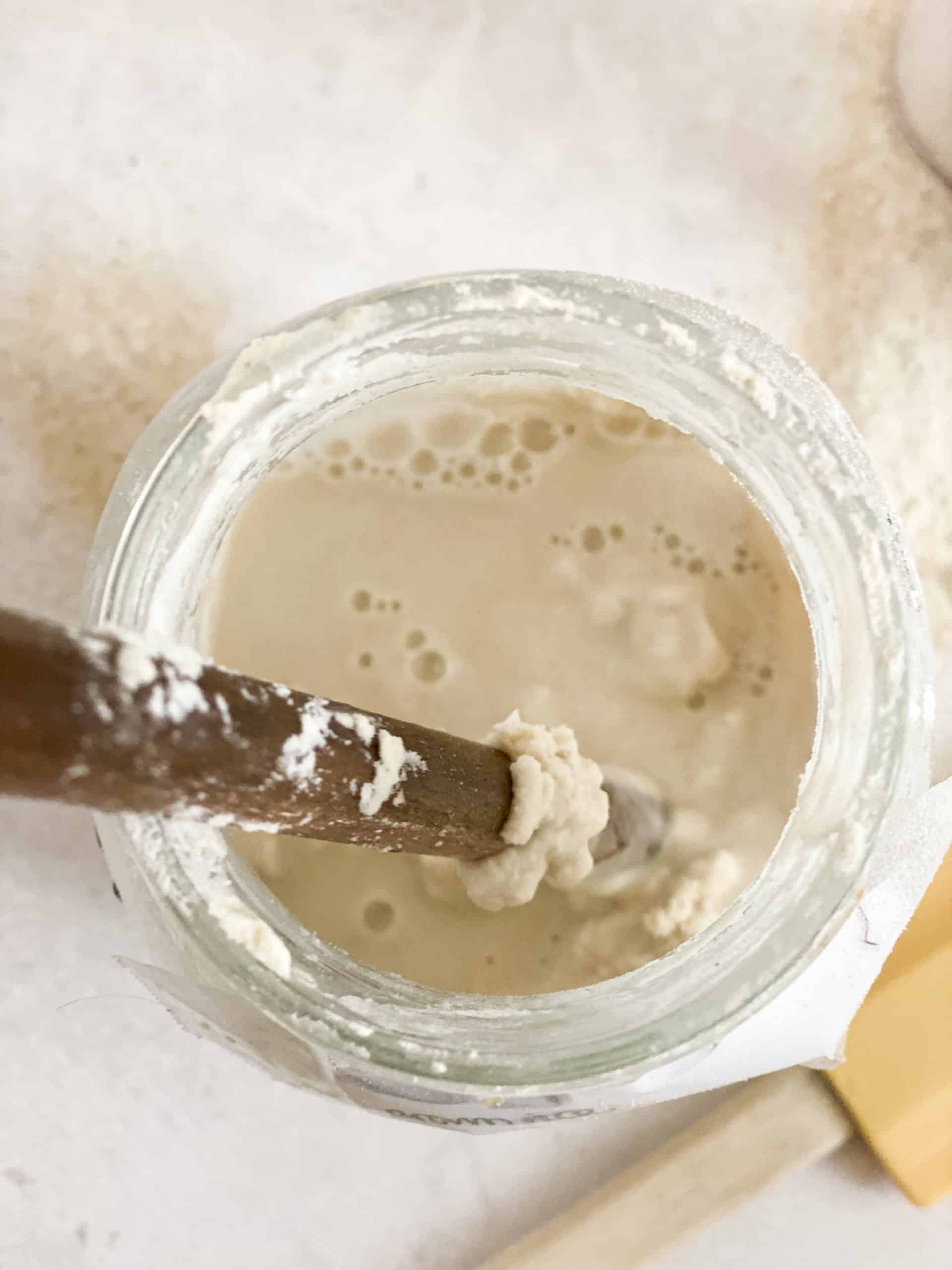
For those with celiac disease or a gluten intolerance, I know how challenging it is to find a safe sourdough or sourdough starter that actually tastes good. But, my gluten free sourdough starter made from scratch is not only delicious, but ensures that no gluten ever touches your starter!
Benefits of a sourdough starter
- So easy to make: With household ingredients, straightforward steps, and a little maintenance, you’ll have a great sourdough starter for a variety of recipes.
- Very versatile: I love to use this starter in sourdough muffins, bread, pizza, and even sourdough crescent rolls.
- Perfect flavor: Many other gluten free sourdough starters have an overly tangy or sour flavor but this one tastes just like a regular sourdough starter. Ensuring nobody ever knows this recipe is gluten free.
- The health benefits: Wild yeast (aka sourdough starter) is created by fermented gluten free flour. One teaspoon of starter contains 5 billion active cultures which is great for the body!
What’s the best gluten free flour for a starter?
Best results come from using single ingredient flours like brown rice flour, sorghum flour, teff flour, and/or white rice flour. You can use a gluten free flour blend, but it’s important to avoid ones that that contain ingredients like bean flour, xanthan gum, or guar gum, as these can impact the fermentation process and the consistency.
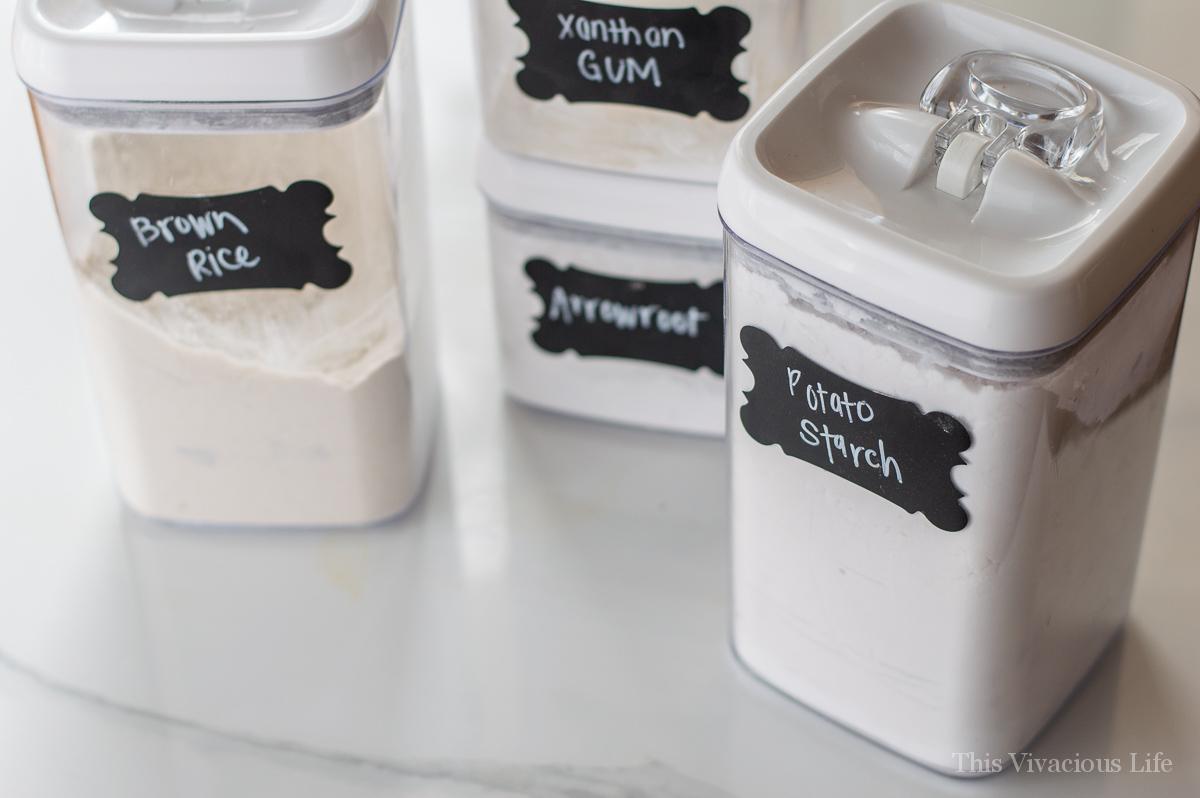
How to make a gluten-free sourdough starter
Day 1: Prepare
Start with a clean jar: Boil a quart size jar and lid to ensure cleanliness
Mix ingredients: Add1/2 cup gluten-free flour and gradually add 1/4-1/2 cup of filtered water until you get the consistency of pancake batter.

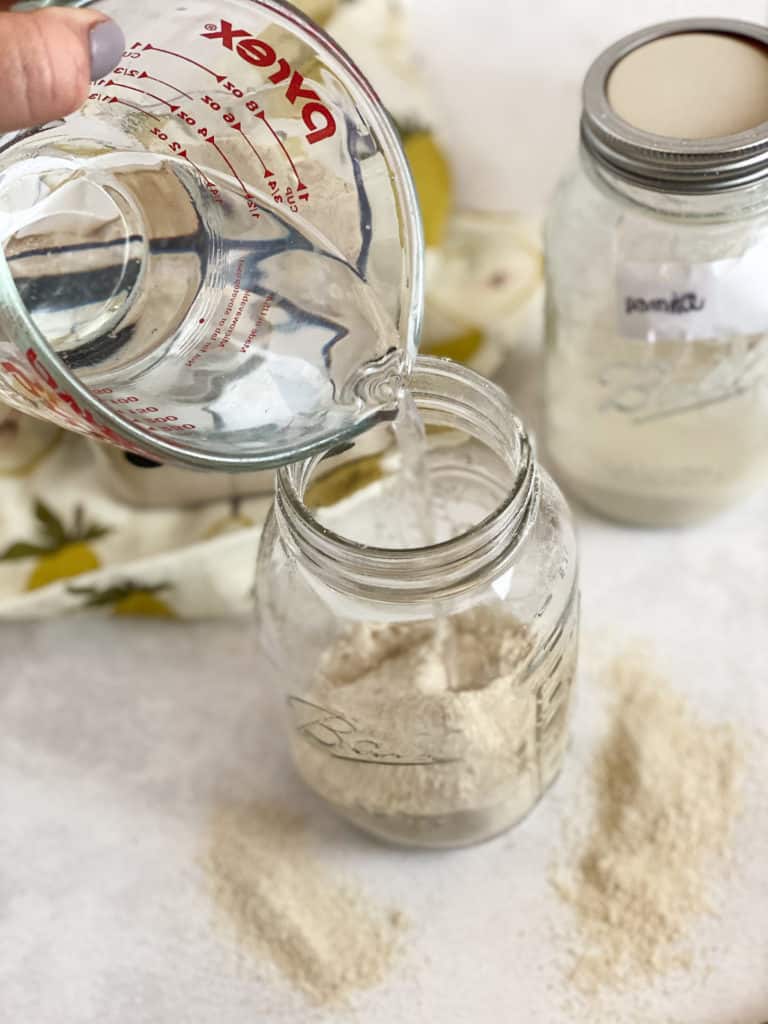
Cover and rest: Place the lid on loosely to allow air to flow. Let sit at room temperature for 24 hours.
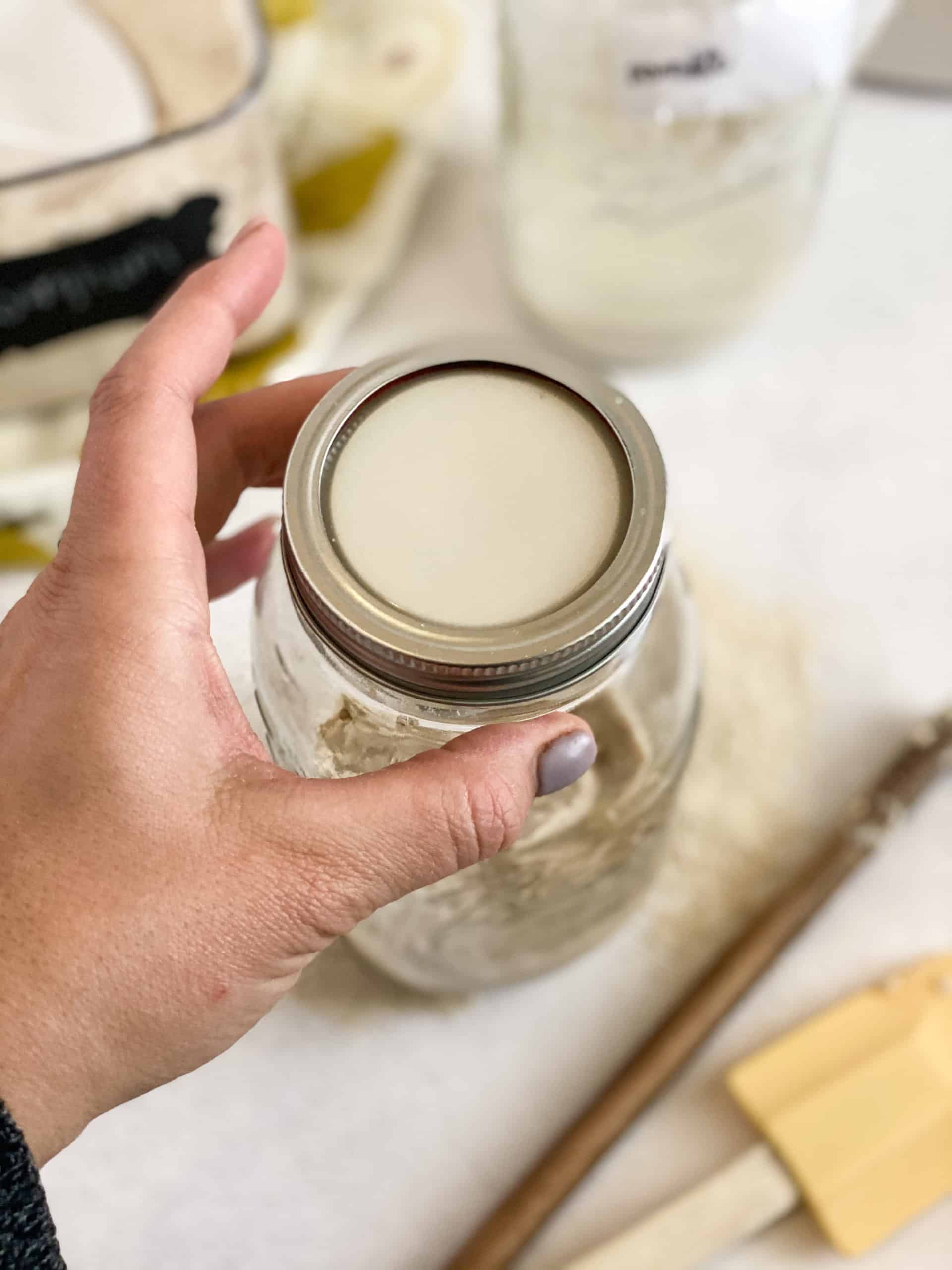
Day 2-7: Feed and maintain
Discard and feed: Each day, discard half of the starter and feed it another 1/2 cup gluten-free flour and 1/4-1/2 cup filtered water. Still well each time.
Cover and rest: Without sealing, cover the jar again while leaving room for air flow. Let rest 24 hours and repeat the discard and feed process.
Scrape the sides: To prevent mold growth, use a spatula to scrape down the sides of the jar.
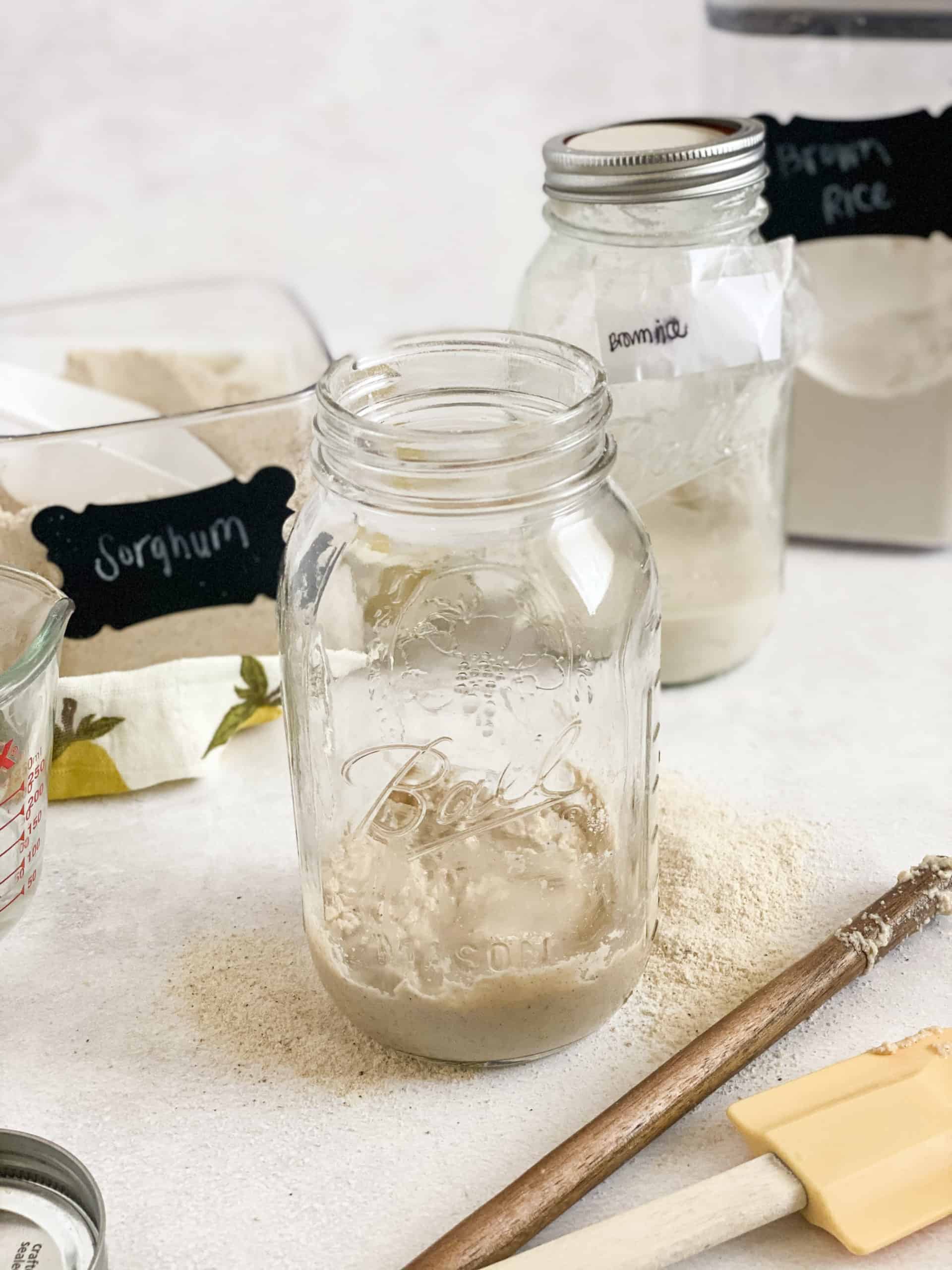
Tips for making the best starter
- Filtered water: You HAVE to use filtered water for your starter as chlorinated tap water will kill your starter. If you don’t know if yours is chlorinated, leave a glass of water on the counter overnight and the chlorine will dissipate.
- Maintain warm temperature: Keep the sourdough in a room temperature to warm temperature for best fermentation.
- Patience is key: Your starter will be ready in roughly a week, it’s best not to try to use it before then.
- Pick the right flour: Brown rice flour or sorghum flour works best, but it’s crucial to avoid gluten free flour blends that contain ingredients like bean flour, xanthan gum, or guar gum, as these will impact the fermentation process and the consistency.
How can I tell when the starter is ready?
You should notice around day 7 that your starter doubles in size a few hours after feeding. In addition, you should see large bubbles on the surface and throughout the starter. If you see these signs, your starter is ready to bake with!
What can I do with the discard?
Throwing out the discard may seem wasteful but if you don’t discard, your starter would get too large. But, the discard can easily be used in recipes like gluten-free zucchini bread and gluten-free biscuits that don’t call for yeast.
How to store sourdough starter
“Feed” your starter every 24 hours for the first seven days. After that, if you plan on baking often, keep it on the counter and feed it daily. If you’d like a bit less maintenance, store it in the refrigerator and feed it once a week at least. You can also take it out and feed it anytime you are ready to use it.
How to make mild or stronger sourdough
- Stronger flavor: Stir in the liquid on top (the hooch) before feeding.
- Milder flavor: Pour out the hooch before feeding.

How to use a gluten-free sourdough starter
When your starter is ready, feed it 1/2- 1 cup of flour and 1/2-1 cup of water depending on how much you need. Then leave it out on the counter for at least thirty minutes to get live (active starter) and happy before using it.
Use 1 cup of gluten-free sourdough starter in recipes that call for dry yeast with 1 C warm milk or water.
I love using my sourdough starter in everything from our homemade sourdough bread recipe and gluten-free pancakes to gluten-free stuffing with our leftover gluten-free bread. The bread dough can be made in a loaf pan or in a dutch oven or cast iron skillet lined with parchment paper for a more rustic loaf.
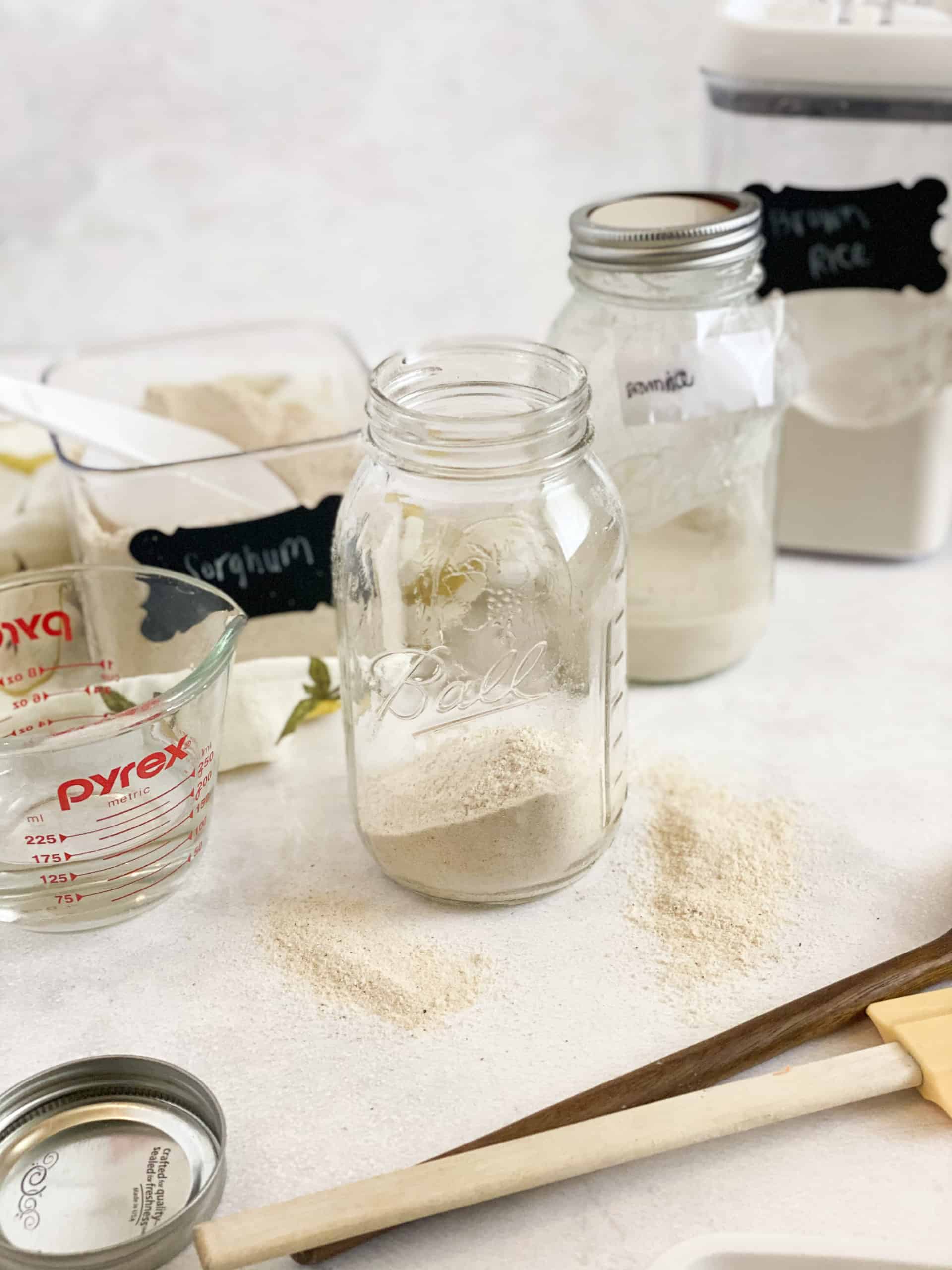
Recipes to use gluten free starter
- Gluten free sourdough
- Gluten-Free Crescent Rolls
- Gluten-Free Buttermilk Biscuits
- BEST Gluten-Free Waffles
- Sourdough french toast
Need an EASY and delicious breakfast, lunch, dinner or dessert?
Take a look at my Sheet Pan Meals and More!
NEED MORE GOODNESS? Follow me on Facebook, Instagram, Pinterest, and Twitter for great recipes, entertaining ideas and more!
Gluten Free Sourdough Starter
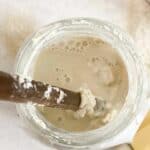
Ingredients
- 3 1/2 cups brown rice flour, sorghum flour or our gluten-free flour
- 3 cups filtered water
Instructions
- Day 1:Start by getting a clean quart size jar. I recommend boiling it and the lid and ring to ensure cleanliness.
- Fill the jar with 1/2 cup gluten-free flour and 1/4-1/2 C water
- Start with 1/4 C then add a little as needed to get a thick pancake batter like consistency. Depending on the flour you choose, it will need more or less water.
- Days 2-7:Remove your lid and discard half of the starter. Feed it another 1/2 cup gluten-free flour and 1/4-1/2 C filtered water and stir
- Place a life UPSIDE down on top and GENTLY PLACE the ring on top. DO NOT, I repeat, DO NOT screw the lid on or it will explode as it does it's thing over the next week.We DO NOT want an airtight seal which is why we put the lid upside down. It gives it some air but not as much as leaving it completely open. You can also put a coffee filter on with an elastic band or a linen cloth. Now, just let it sit out at room temperature until tomorrow when you will go onto the next step…
- Scrape down the inside of the jar with your spatula to reduce the chance of mold growing, then put your lid back on (not airtight) and let it sit on the counter again for another 24 hours
- Repeat this process of discarding half and then feeding it everyday for seven days. When your starter doubles in size within a few hours after a feeding, it is ready to bake with!
Notes
Tips for making the best starter
- Filtered water: You HAVE to use filtered water for your starter as chlorinated tap water will kill your starter. If you don’t know if yours is chlorinated, leave a glass of water on the counter overnight and the chlorine will dissipate.
- Maintain warm temperature: Keep the sourdough in a room temperature to warm temperature for best fermentation.
- Patience is key: Your starter will be ready in roughly a week, it’s best not to try to use it before then.
- Pick the right flour: Brown rice flour or sorghum flour works best, but it’s crucial to avoid gluten free flour blends that contain ingredients like bean flour, xanthan gum, or guar gum, as these will impact the fermentation process and the consistency.
Nutrition
This post was originally posted on January 27, 2021 but has since been updated (May 2023).
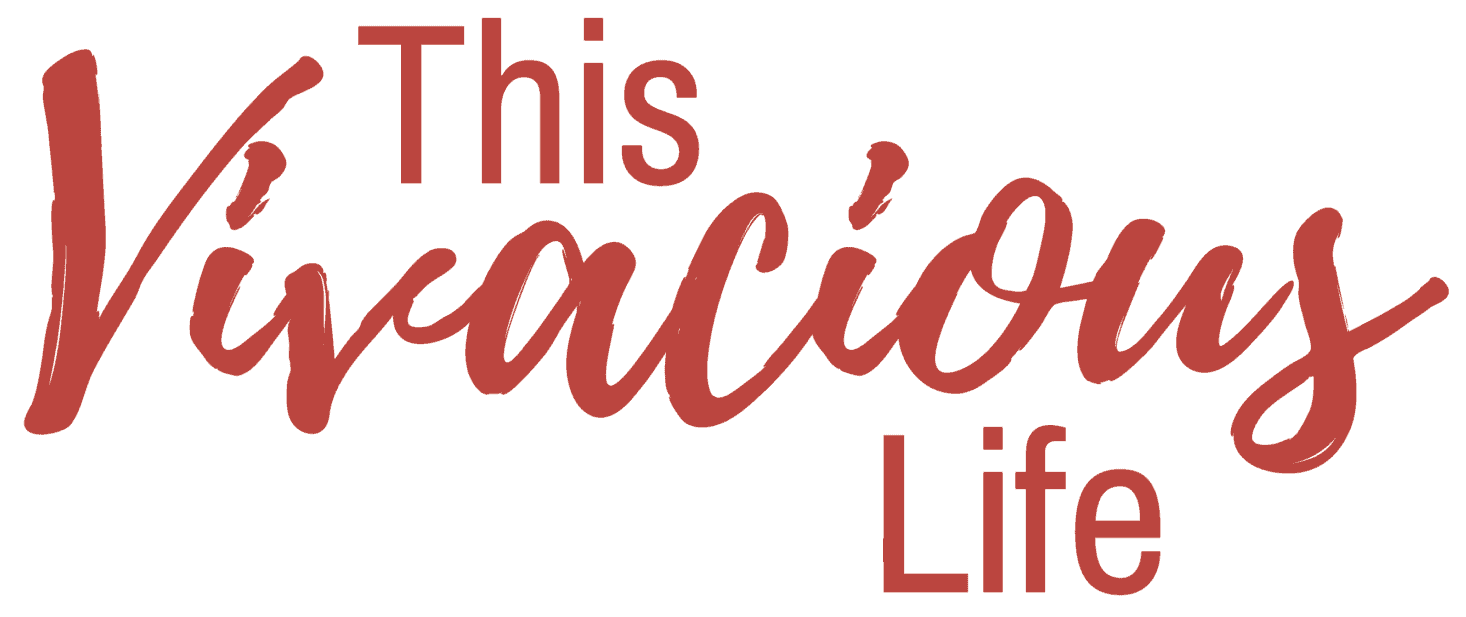

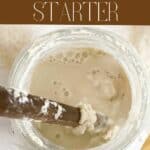
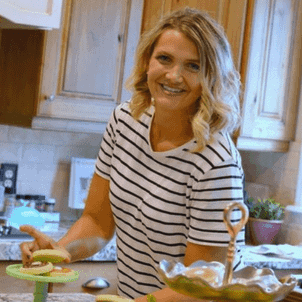
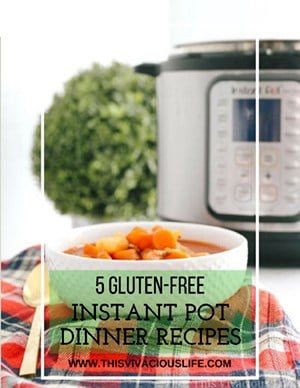

Juliana says
Does white rice flour work as well as the brown?
Chandice says
It does but not as well. It will be more starchy. I’d recommend brown rice or sorghum.
Rachel says
How warm does the environment need to be? When my microwave light is on, my microwave internal temp is 78 degrees. Is that too warm? We keep the house at 68-70 which I feel is a bit too cold to be ideal. I also have a proofing box and could set the temp at a constant 73 degrees? Thoughts? Am I overthinking it? When I made my regular sourdough starter, it was summer time and the house was always pretty warm (we live in TX)
Chandice says
I think the proofing box is the best. 78 degrees could also work but it would be pretty warm. I think under 70 degrees is pretty cold. It will be great no matter what as long as it is somewhat warm…
Tammy says
I didn’t realize how easy it would be to make GF sourdough…loved this! I love homemade bread.
Jacqueline Debono says
Great post and tips! I’ve been looking for a way to make a GF sourdough starter and this is it!
Heather says
Got quite into sourdough but I have some friends that requested GF bread … this was great to make some this week!
Adriana says
I have been brave enough to make a sourdough starter, but I am ready to try with your tips now. Thanks for all the detailed instructions and expert advice. Loved baking my first sourdough bread at home.
Veronika Sykorova says
I always thought making a started was complicated, let alone a gluten-free one! But you make it seem easy and explain it really well. I appreciate all the step by step photos you add too!
Cathleen says
I have always been too scared to attempt to make sourdough starter, but you break it down in a way that I think is doable! Definitely easy! 🙂
Leslie says
There’s just nothing better than a freshly baked slice of bread. Your instructions with this Gluten-Free Sourdough Starter are perfect! Thank you!
Angie says
Homemade bread is the best kind of bread. And a gluten-free sourdough starter is even better. I because it cuts the bloated feeling I get from other breads that are not gluten free. Excellent details and recipe!!
Sharon says
You make this sourdough starter look easy, and I really love that it is gluten-free too!
Chandice says
Thanks Sharon, so glad you love it!
Megan Ellam says
Oh I love this idea for a gluten free loaf. I am absolutely making it again!
Marie says
Thank you for this detailed guide! I read through the whole thing and started my starter this weekend. I can’t wait to try all your recipes!
Chandice says
Thanks Marie, I can’t wait to see all our GF sourdough success!
Bailee says
This is so great! I love all the health benefits and I love that it can be used in so many different recipes. It took time and consistency to do, but it’s so worth it!
Chandice says
Thanks Bailee, I am so excited to have you enjoy the benefits of gluten-free sourdough!
Tana says
I love that sourdough can be done gluten free! The brown rice starter is amazing! Thanks for researching this and passing on this great, useful information to all of us! Very helpful!
Love Mom
Chandice says
Thanks, so glad you are enjoying your brown rice starter!